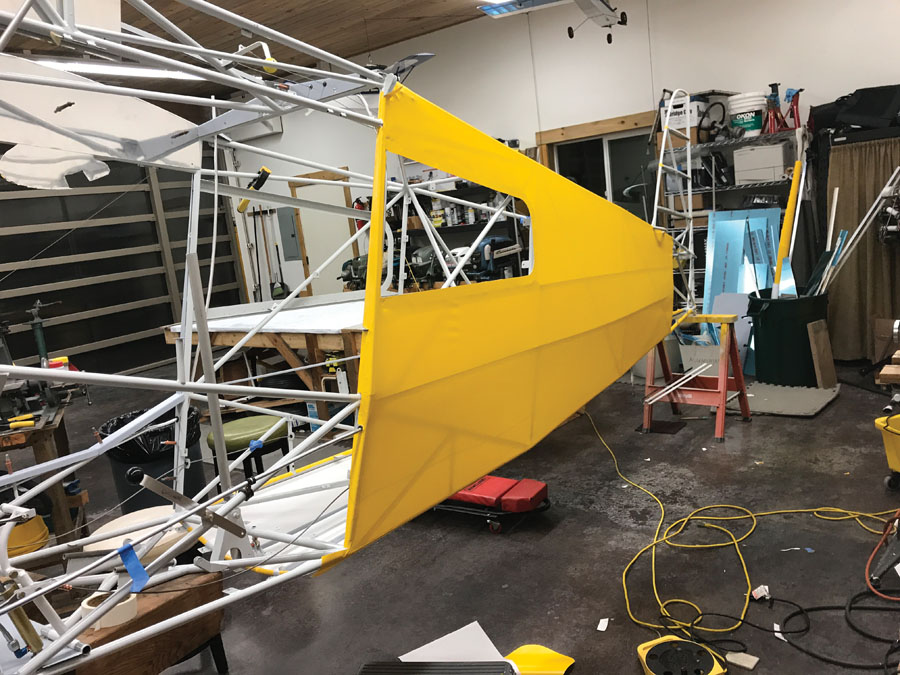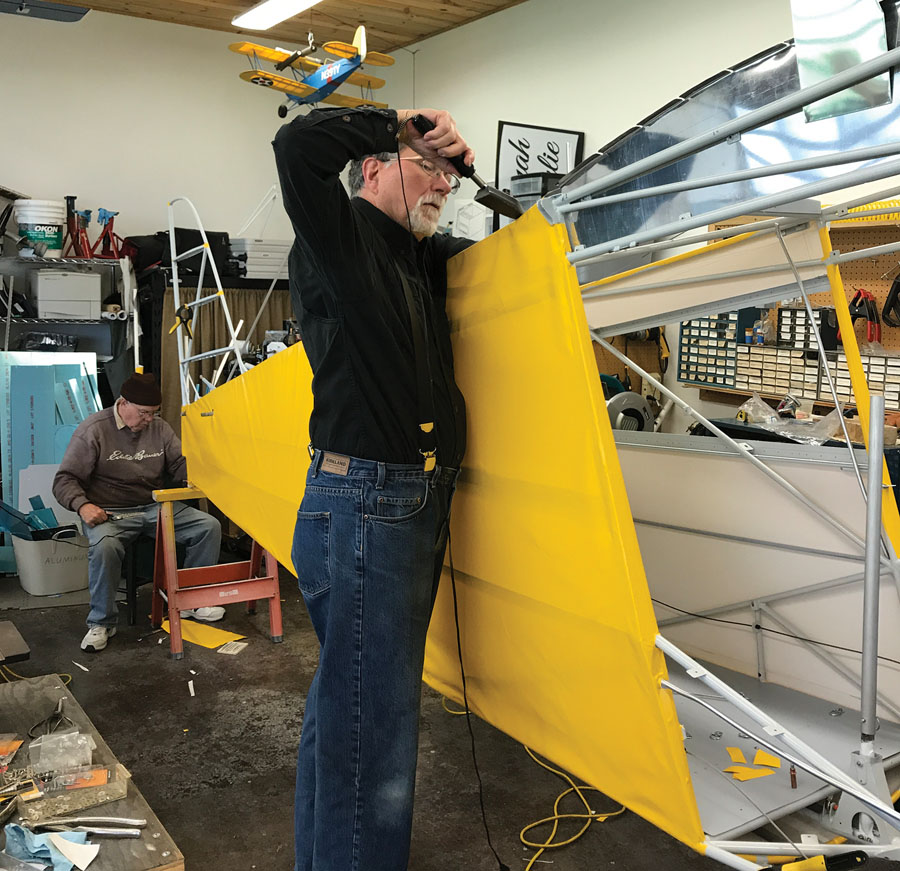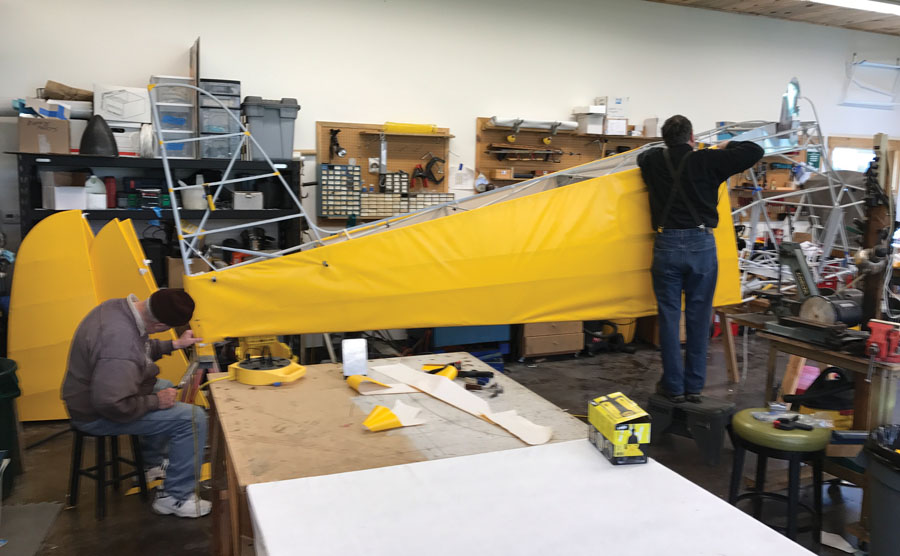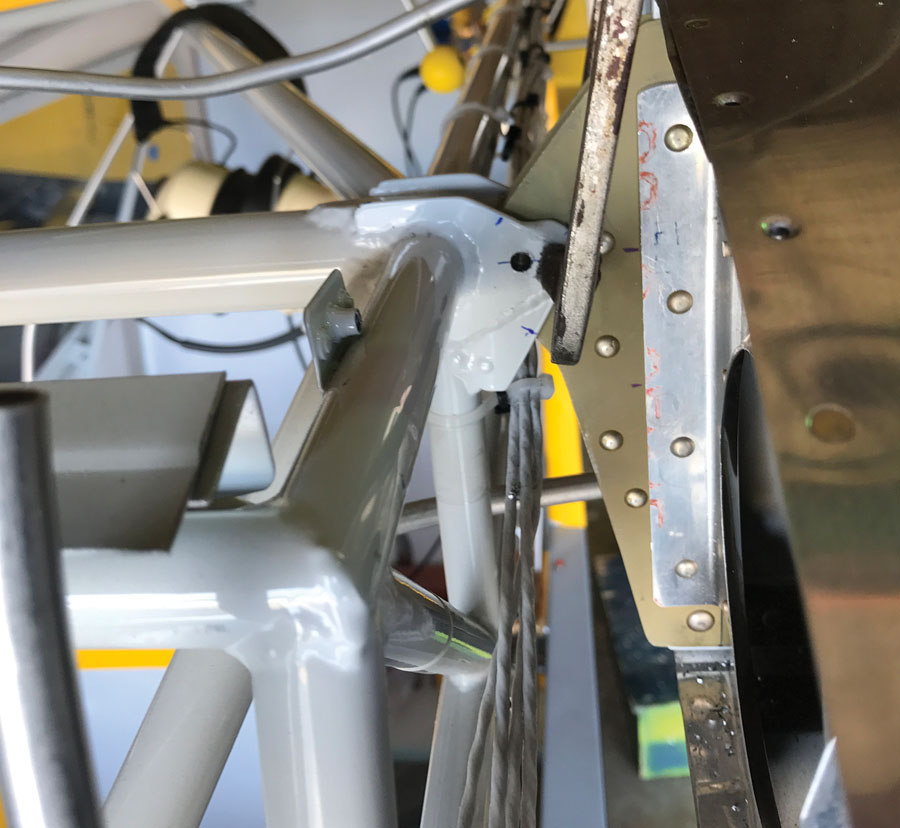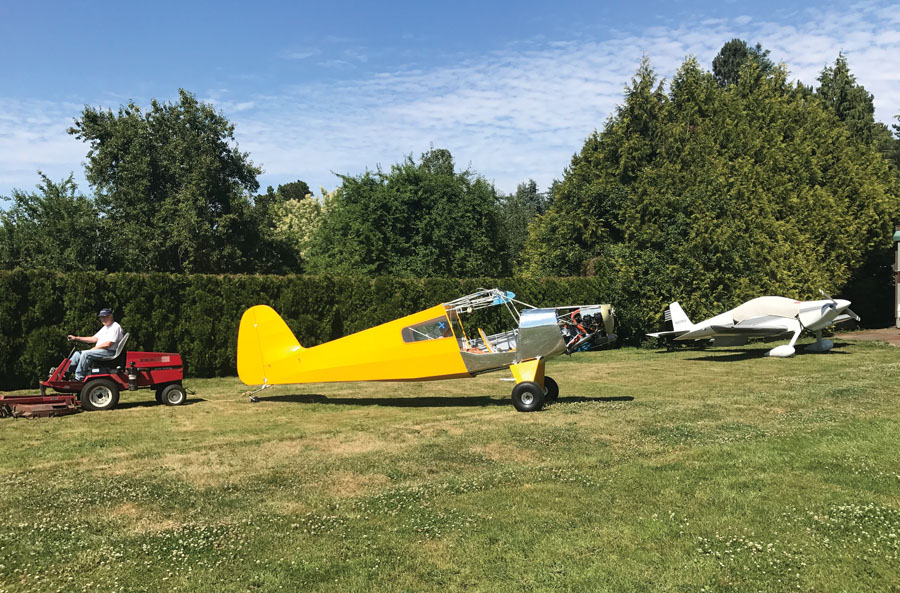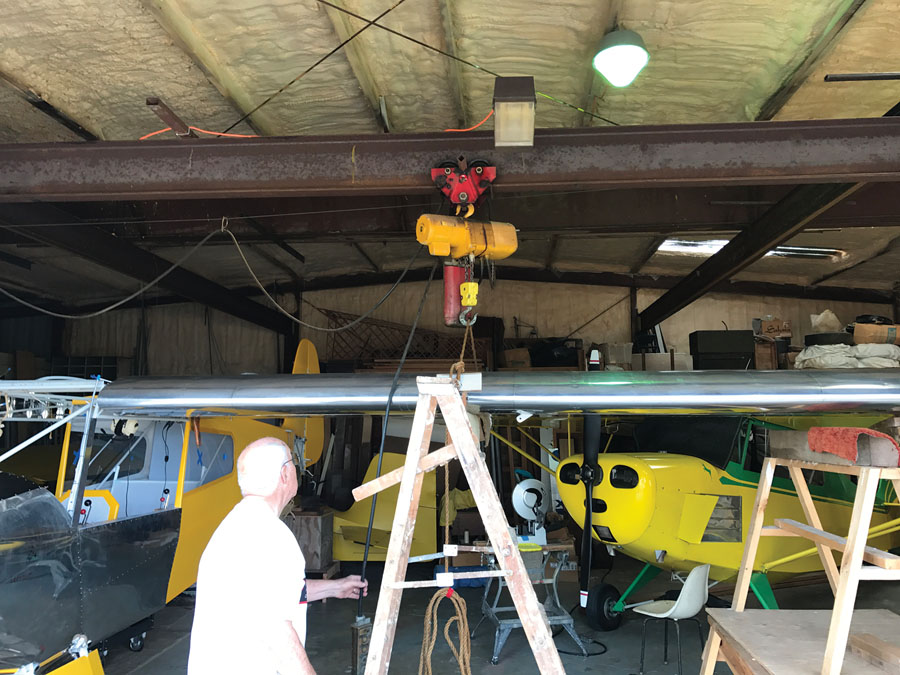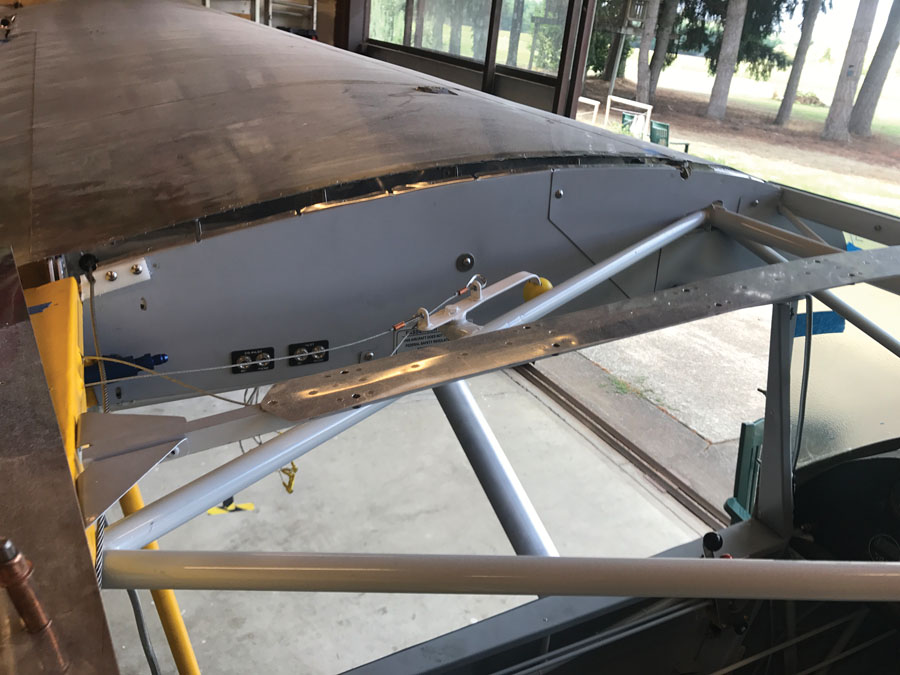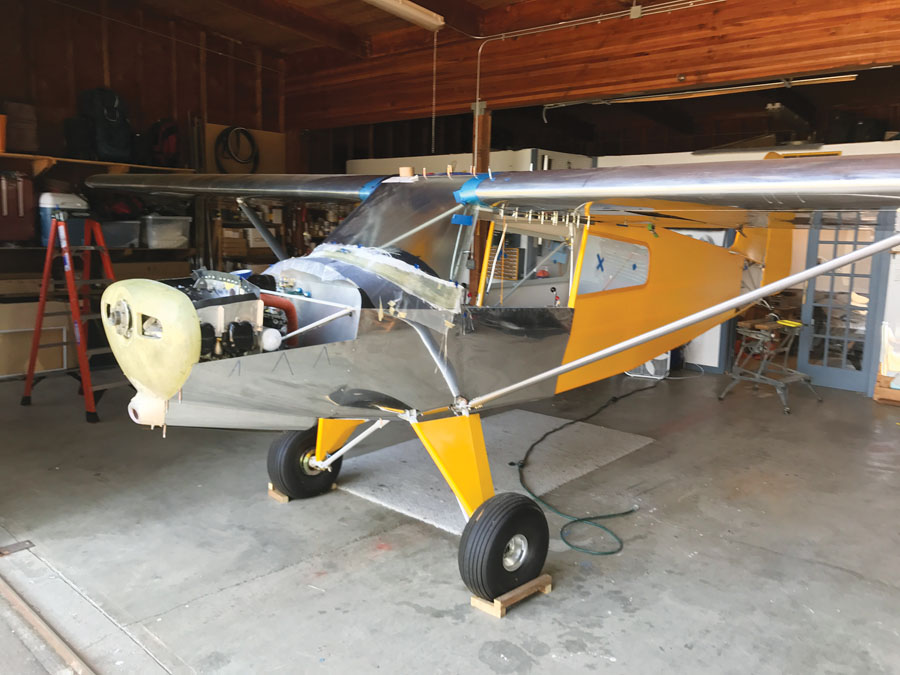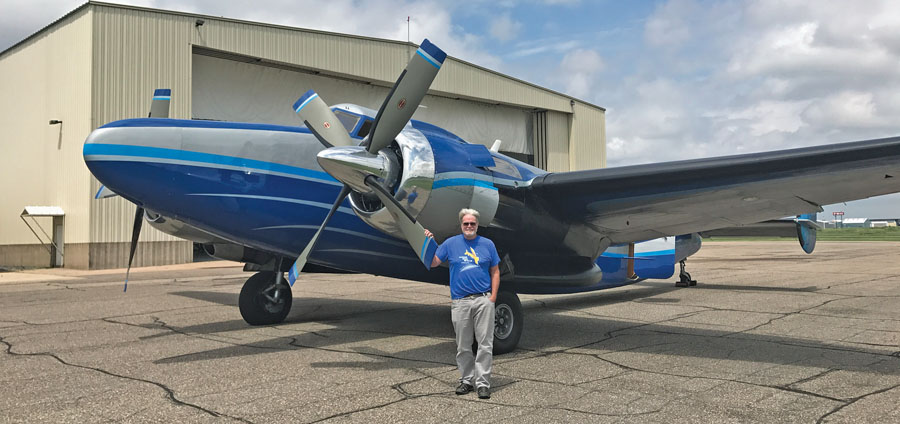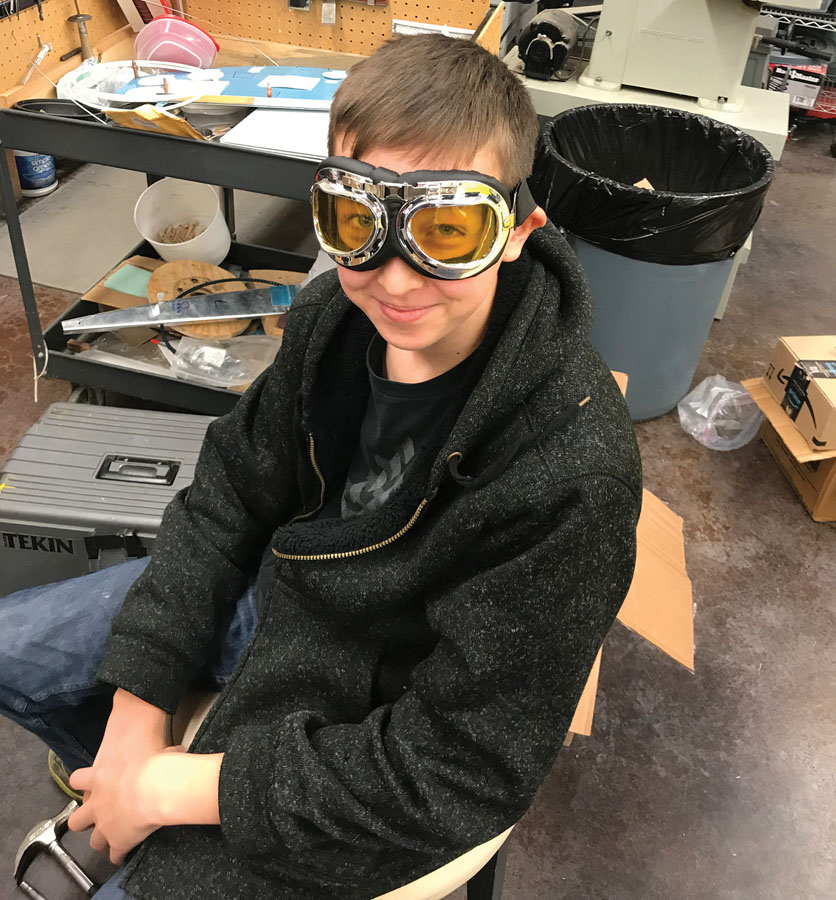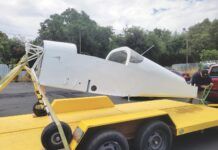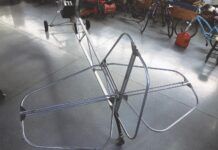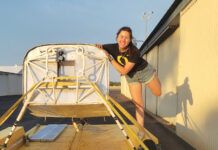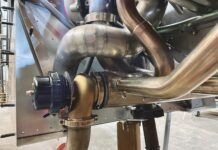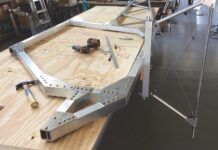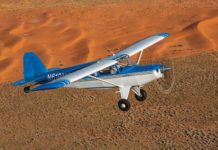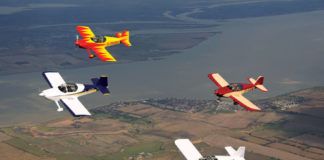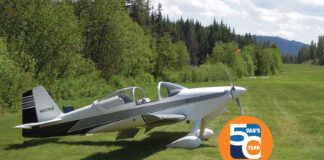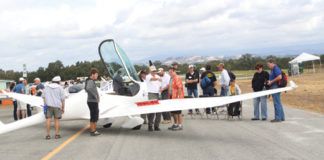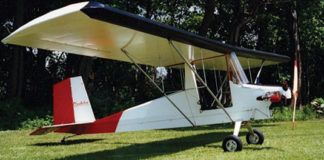As you may recall from our last exciting episode, the ForeverHawk fuselage had progressed to the point of having all the sheet metal skins, floorboards, and rear cabin bulkhead made and fitted. That took care of the fuselage from the rear of the door forward, but left the aft fuselage and tail surfaces buck naked. These, along with the ailerons, are the only parts of the airplane that are covered in fabric.
Rion Bourgeois applies heat with an iron to activate the adhesive used with Oratex fabric. Oratex is fairly easy to work with, but the procedures are different than other covering systems.
We went through the usual dithering: what fabric system, where to get it, etc. Philip Groelz was the only one of us who had actually covered an airplane with fabric, and he’d used the water-soluble Stewart Systems process. He found it simple to install and easy to clean up. However, the Christavia project was finished before the new Oratex covering system became available.
The purveyors tout the advantages of Oratex: no fillers or paint necessary, water-soluble glue, easy to work, and significantly lighter than traditional systems. Of course, these claims come from the folks who are trying to sell you the stuff, so we sought a real-world opinion from Steve Harris, who’d used Oratex on his four-place Bearhawk.
Philip Groelz, on the left, and Rion Bourgeois install Oratex fabric on the aft fuselage. The completed control surfaces are in the background.
“It depends on what you’re after,” Steve told us. “If you want a polished finish that looks six inches deep and comes in any color, Oratex isn’t it. It’s kind of flat, 100LL stains it, and it only comes in six or seven colors. It’s OK to work with, but there’s a learning curve. It is light, but it is not cheap.”
Even with the price, we found the advantages appealing, especially the weight savings. When we found a roll of new Oratex left over from an abandoned project for sale at a price that made it competitive with new Stewart Systems materials, we took the plunge, thereby making the ForeverHawk a yellow airplane.
Dan Horton wrote a good article [“Oratex Aircraft Fabric: Covering Made Easy,” July 2014], comparing Oratex to other systems and describing some of its foibles. We found his observations and Steve’s comments to be right on the mark. Rather than rehash those, let’s just say we learned our way through the process, and the fuselage, landing gear, and tail surfaces are now covered in taut yellow fabric. It wasn’t that much fun, but when it’s done, it’s done. No painting! The biggest problem we encountered was that the material we bought was three years old. It hadn’t deteriorated, but all we got was fabric—we needed tapes, glue and other supplies. When we ordered them from the American Oratex dealer in Alaska, we found that European regulations had forced Oratex (a German company) to reformulate their product, and the colors had changed slightly. The dealer tried, but they were not able to find tapes that matched our material. The difference is subtle, but noticeable. We followed the old dictum, “If you can’t match it, feature it,” and declared our tapes “accent stripes” and learned to live with the mismatch. It wasn’t hard.
The wing spars fit between steel lugs welded on the fuselage. Each one is attached with a single bolt to the fuselage. Simple T-stands were used to hold the wings steady during installation.
Fitting the Wings
With the fuselage covered and the engine installed (more about that later), it was time, at long, long last, to fit the wings. This is simple enough in theory—the front and rear spars fit between steel lugs welded on the fuselage and are fastened with a single bolt through each. The angle of incidence is set by inserting the wing and adjusting it to the 1-degree angle prescribed, then drilling the bolt holes. The dihedral is set by raising the wing tips and cutting the single strut to the correct length. You get one shot at each hole/cut.
With the fuselage covered and the engine installed, the ForeverHawk was towed to Philip Groelz’s hangar where an overhead gantry crane was used to fit the wings.
Philip’s hangar has an overhead gantry crane, and Rion Bourgeois needed his hangar space back to accommodate his ever-growing boat, junk, and antique outboard motor collection. That made it desirable to do the wing fitting at Philip’s, so we towed the fuselage, on its own wheels, down the runway and leveled it up under the crane.
A gantry crane was used to lift the wings up to the fuselage. Simple T-stands were used to hold the wings steady during installation.
When the crane lifted the wings up to the fuselage, we immediately realized why we should have done this much earlier in the build. Actually, we had discussed that, but getting the wings into the rafters of my hangar had required five men and a supervisory poodle. Getting them down again was just too much effort (or so we thought), so we made a jig off the exposed root end of the left wing and used that to weld the lugs onto the fuselage. After all, the main ribs, which determined the distance between the spars, had all been formed on the same form block, so the same jig should work for both wings. Right?
Wrong. In a couple of ways…
Aluminum ribs support the skylight. The ribs attach to tabs welded on the fuselage and were adjusted to match the curve of the upper surface of the wings.
Getting the wings down with four people (and the same poodle) took about 15 minutes. When we fit them to the fuselage, the left wing fit perfectly. Somehow, the fittings on the right side were 0.060 inch too far apart. That’s less than a sixteenth of an inch. There are very few places that would have mattered, but this was one of them. There wasn’t anything we could do but cut the lug off the fuselage and weld on a new one. We’d had the fuselage powder coated months before, and the welding torch didn’t do that any good at all. Still, in one long afternoon, the new lug was made, welded, and painted to match.
We fitted the wings individually, suspending them from a sling on the crane and using a couple of simple “T-stands” to hold them steady. Some careful work with carpenter’s levels, both bubble and digital, set the incidence and dihedral angles. We’d purchased the strut fittings from Bearhawk. (There’s a whole plans page on how to make them with a mill, belt sander, and drill press, but we figured by this time we’d earned our scratch-built airplane merit badge and just bought them. They’re beautiful.) But when we tried to insert them into the ends of the streamlined aluminum tubing (also purchased from Bearhawk), they were too wide to fit inside the strut. We’d just about decided to mill them down the 0.100 inch or so required to make them fit, but we decided to give Mark Goldberg at Bearhawk a call—somebody must have encountered this.
“Do not mill them down!” Mark told us. “Bob (designer Bob Barrows) has run the numbers and says the fittings need to be full size. If you put the ends of the struts in a big vise and squeeze them, they will open up enough to insert the fittings.”
I ended up one short on stainless steel area washers. I noticed a penny was almost exactly the same diameter, and when I put it on the gram scale in the shop, it weighed about 40% as much as the stainless washer. Now, stainless washers are .09 each when you buy them at Wilco, and a penny costs…
I looked at those beefy struts and thought: no, they won’t. But Philip has a megaton Polish vise, and when we put the struts in it and cranked, sure enough, the fittings slid right in. We measured and remeasured the airplane to determine the length of the struts. Then we walked around the airplane, had a cold drink, and measured it again. Then we took some deep breaths and cut the struts to length with our chop saw. That took about ten seconds and the cuts were perfectly square and smooth—finally, something that went quickly.
After two days, we had the spars drilled, reamed, and bolted to the fuselage, and the struts completed and in place. We made tie-down loops out of stainless steel hoops we found at Wilco Farm and Aircraft Supply and used the upper strut bolts to install them. Wings installed.
Then Reason 2 for fitting the wings earlier showed up.
The Cabin Top
The plans show sketches of a couple options for the cabin top. The simplest is just a couple of steel tubes, curved to match the upper surfaces of the wings and welded to the top longerons. They support fabric stretched across the top of the cabin. Simple, light and easy. The second option is a skylight, supported by steel channel in place of the tubes. Much more time consuming, heavier, and more expensive. You can guess which one we chose…
Without the wings in place, making the curved tubes match the airfoil arc would be pure guesswork. We decided instead to make aluminum ribs that would attach to tabs welded on the longerons. If we slotted the screw holes, we could adjust the ribs to match the wings when we finally got them out of the rafters. The flanges of the ribs would support the outboard edges of the skylight and the inboard edges of the aluminum fairings that cover the gap between the inboard wing rib and the fuselage. It seemed reasonable at the time.
And eventually, it worked. But instead of two evenings installing fabric, I spent a long week of full days making three-piece ribs that fit around the steel-tube trusswork of the cabin tip. I then spent most of the next week making aluminum wing root fairings—four pieces on each side. Much of that work required standing on a ladder or twisting my upper body into the cabin. After the fairings and ribs were fitted and drilled, there were about sixty #6 nut plates to be installed. I’ve installed an awful lot of nut plates over the last 30 years, and the thrill is just about gone—so this is where Jack the Hangar Rat comes in.
Jack the Hangar Rat did a great job installing nut plates, even the difficult ones on the bottom of the wing.
Jack showed up on our airpark two years ago, riding his bike from his home about four miles away, pedaling up and down the strip offering to do anything a 13-year-old could do to be around airplanes and maybe get a ride in one. Since then, he’s put a lot of miles on that bike, working at least four local airports and flying everything he can work his way into. (“An A-36 Bonanza is lighter on the controls than a Cessna 210,” he says. “And the RV-6 is really fun!”) In another year or two, he’ll be an enthusiastic private pilot, and who knows where he’ll be in 10 years time—if he’s managing two large turbines over a big ocean, I won’t be surprised.
For now, though, he gets the scut jobs—running the dog, pulling the weeds in our gardens, washing the belly of airplanes…and installing nut plates. I made him write out a list of instructions for the job, then we went over them together. There have been several times on this project that I wish I’d done the same for myself. Jack’s written instructions were pretty good (must work on spelling, Jack!), so after reviewing them we turned him loose. He did just fine, even on the difficult ones on the bottom of the wing.
So at the end of August the wings were on. Rion and I took on the task of installing the tail components and hooking up the controls while Philip went to work on the other end of the fuselage, finishing up the sheet metal cowling. At long last, this thing is beginning to resemble an airplane.

